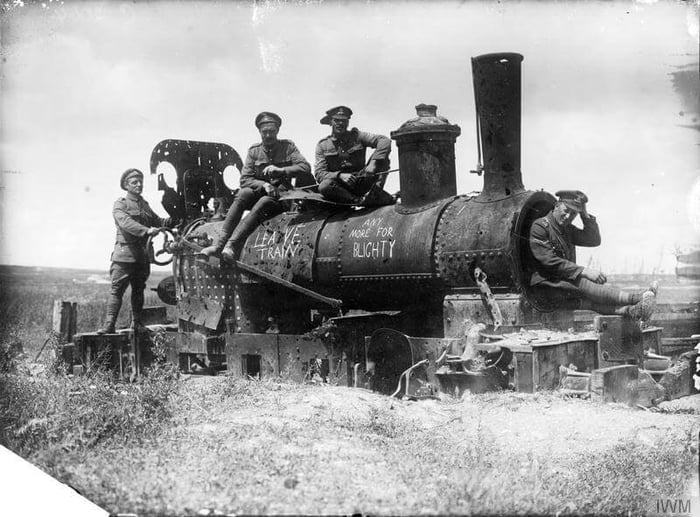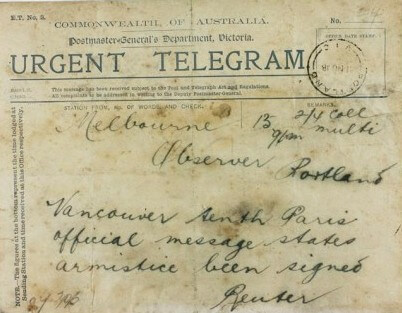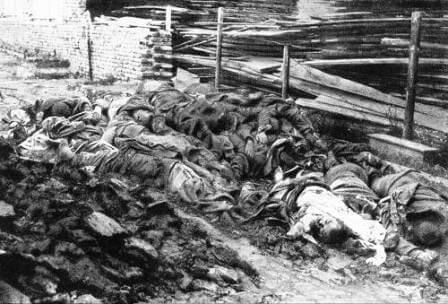
Australia's Railwaymen at War
Image: Light railways were important to all sides in the Great War. The above photograph shows Allied troops posing with the wreckage of a German light railway engine near Peronne.
The Railway company was formed in Australia as No. 5 Section, Railway Unit, AIF and members were initially concentrated in Royal Park Camp until 23 March 1917. After the closing of the camp these men were transferred to Broadmeadows, NSW. Concentration from all states was completed on 9 May 1917 and the Railway Unit embarked from Port Melbourne aboard HMAT Ascarius on 11 May 1917.
A compliment of 3 Officers and 266 Other Ranks, all specialist railwaymen and tradesmen, made up the Nominal Roll. The ship sailed for England on a voyage that took 70 days, stopping at Fremantle, Mauritius, Durham, Cape Town, Sierra Leone, and finally arriving at Devonport on 19 July 1917, the men disembarked at once and were transported by special train to quarters at St Lucia Barracks in Bordon, East Hampshire. On arriving the Railway Unit was isolated due to infectious diseases which had been contracted on the voyage. Initial training involved Gas Drill, Company & Musketry Drill, with instruction carried out by Royal Engineers officers and NCO’s. On 28th Jul 1917, the Railway Unit was inspected by the King and Queen, along with HRH Princess Mary.
On 28 August 1917, No. 5 Section, Railway Unit, AIF officially changed its name to the 16th (Australian) Light Railway Operating Company; all final stores were issued and the members were given embarkation leave. Later orders were issued for transport to France by Southampton on 5 September 1917. Once the Company reached Le Havre in France they moved quickly to Poperinghe (Poperinge) Belgium. Throughout the Great War 1914-1918 Poperinge, or “Pops” as the British soldiers called it, was used by the British Army as a gateway to the battlefields of the northern Ypres Salient. It was an important rail center behind the front line and was used for the distribution of supplies, for billeting troops, for casualty clearing stations and for troops at rest from duty in the forward trench areas. Tens of thousands of men passed through this small town over the course of the war.
The main square formed the hub of five main roads leading into the town and, therefore, was constantly bustling with military traffic, military personnel and the few civilians who had stayed on in the town. Because of its importance to the military in supplying the front the town was frequently targeted by long range German artillery. During the Third Battle of Ypres (31 July - 10 November 1917) Poperinge and the surrounding area was bombed by German aircraft. Some bombs landed on the Casualty Clearing Stations nearby. The 16th (Australian) Light Railway Operating Company was thrown into this chaos. Upon arrival at Ellarsyde Depot the Company was put straight to work supplying engineers and guards for light railways running right into the forward positions, and supplying innumerable tons of munitions and stores.
On 20 September 1917 a major offensive began at Ypres, this kept the Company busy running loads of ammunition and other supplies to the front and returning with wounded, both Allied and German. By 27 September 1917 with the offensive still underway the Company suffered its first injuries, being so close to the front the railway lines were specifically targeted by German artillery, especially near the area known as “Bedford junction”. The Company was operating in support of the 2nd Army and was primarily involved in forwarding materiel to the forward areas. But it also played a major role in bringing back the wounded to the Casualty Clearing Station's and dressing stations.
The Company also faced treacherous conditions unrelated to the Germans. Heavy rains in October 1917 had caused problems for the light railways and lead to a number of derailments. They were spread all over the sector behind the 2nd Army, before being concentrated at Vauxhall Depot near Voormezeele. By November 1917, with a lull in the action, work for the Company eased and work on the Depot could be finished. With Shedding for the Loco’s and a water system completed, the engines could be kept out of the elements and water no longer had to be drawn from shell holes.
On 10 November 1917 both CSM Davis and A/CSM Ryan (my grandfather) were promoted to Warrant Officers, backdated to 11 October 1917. The monotonous daily diary entries demonstrate the harshness of war; "many German/”Fritzie” aircraft over lines and bombing"; "heavy shelling all around depot "; "heavy Naval guns firing from spur lines behind depot"; "firing all night"; "moving troops, munitions and materiel to front; "moving wounded from front". The availability of these trains to transport troops to the front from the rest areas in the rear (usually in open trucks averaging 100-250 per train) was vital to Allied success. Amongst other things it meant that the troops were arriving at their lines still fresh and not exhausted from slugging through the mud. On the 10 December 1917 the Company pay day also included voting in the Australian referendum for “Selective Reinforcements” (i.e.. conscription), and the German planes dropping leaflets about their great victory at Cambrai.
Christmas Day 1917 commenced with a heavy artillery barrage at 05:30 , followed by light rain until about 10:30 when snow commenced to fall and continued throughout the day. This made for good winter sports and snow balling (particularly as most of the Company had never seen snow before). Dinner consisted of boiled ham, roast beef, potatoes, cabbages and turnips. Followed by plum pudding, tea and a “liberal rum issue”. Officers then issued YMCA gifts to the men, consisting of a book, pocket wallet and 2 additional “green envelopes”. No mail was received from home.
During the Great War, the Post Office played an important role in uncovering espionage activities and preventing the leaking of military secrets through interception of mail. Letters sent by the soldiers from the Front were therefore heavily censored. In March 1915 green envelopes were introduced for the express purpose of troops being more freely able to communicate personal information. The green envelopes were signed by the sender verifying that they contained only private and family matters. The "Honour" envelopes were exempt from censorship, thereby lightening the workload on censors, as well as making it possible for the troops to share deeply personal information with their loved ones. It’s a powerful reminder of a time when honour was taken very seriously indeed. Honour envelopes were also called “lovers” or “married man’s domestic troubles”.
The beginning of 1918 found the members of the Company again spread all over the 2nd Army sector, attached to English, Canadian and Australian units. On 5 March 1918 the Company’s name was again changed this time to 2nd Australian Light Railway Operating Company. By April the Company was preparing to withdraw and move to the 2nd Corps sector. On the evening of 11 April 1918 a party consisting of the Officers, WO’s, QMS and 5 OR’s took a push truck of water, tea and all the spare food, including some 3500 packets of cigarettes donated by the Company members, to the troops holding the line immediately in front of the Depot. Leaving enough men behind to continue operating relief to the front lines and to hand over to the New Zealand Light Railway Operating Company. After this the Company moved first to Hitchin D6 then to Swiss Cottages, Pretoria and finally to Heidebeke (Heldebeek) between Proven and Crombeke (Krombeke) on the French border. Camped in a paddock everyone needed to work hard to set up the new depot while still operating the rail lines.
On 30 April 1918 a tremendous accident occurred when a train of ammunition was being moved and one of the cars caught fire. In attempting to move the lit car away from the rest of the trucks the train crew was able to get only about 500 yards before it exploded, setting off the other cars and hurling the engine some 150 yards. Pieces of the engine and trucks were found up to 1000 yards away with pieces of shells and even complete shells even further afield. Around 200 yards of track was destroyed and tremendous cavities in the ground masking where the trucks had exploded. On the 11 May 1918 the Company celebrated its first anniversary since embarkation from Australia. Sporting activities occupied the morning, old buffers race, tug of war, kicking football, 100 yards championship, obstacle races and more. With the afternoon taken up with three games of football (Australian, Rugby and soccer) the latter game against a Belgian team who won the game.
In this new location the Company was responsible for the main line, sidings, spurs and yards between “Swiss Cottage and Truro (near Mendinghem)”, this line was an emergency line that needed to be upgraded quickly to be ready to carry troops and munitions for the coming offensive. Accessing materials for ballasting the lines for this job was extremely difficult and only solved by tearing up an unused siding, conveying it a distance of 2 chains by wheelbarrow before finally loading it into trucks to be taken to the main line and utilised as needed. All of this, as well as loading and unloading from the Broad Gauge lines to the Light Gauge lines, as well as infantry training and musketry training, was extremely taxing for a technical unit specialising in operating a railway. The Company had to lay a new line entirely on its own.
On 22 June 1918 a successful night action was carried out by 33rd Division in which the Light Railway, and in particular the 2nd ALROC, played a very significant part. Acting under orders, 3 CSM’s, 8 Tractor Drivers and 8 Guards departed from the Depot with one tractor and truck. Five tractors were picked up at Vox Vrie and a further two tractors at Peselhoek. Here they were connected up to 7 trains of seven box trucks each, each truck containing an average of 40 loaded gas cylinders, and proceeded to Braudhoek. The first train departed at 19:30 with the remaining six departing at 5 minute intervals, followed by a breakdown train. Some slight delay was caused by derailments but all arrived safely at their destination. As the success of the operation depended on secrecy quietness was essential and it was considered essential to detach the tractors of the 1st, 2nd and 7th trains at Castle Siding and hand shunt the trucks into position on a double track between Bedford Junction and Tunnel Junction (on account of these tractors rattling and making noise).
The 3rd, 4th, 5th, and 6th tractors were detached at Trois Rois, and stood by in the siding. The trucks were successfully hand shunted into position so that 49 trucks were in one line, the last rake being placed at 12:15 on 23 June 1918. The cylinders were connected and the gas was discharged in one dense volume at 12.54. The trucks containing the empty cylinders were hand shunted back to Trois Rois siding, where they were picked up by the waiting tractors, the last train departing at 02:10 the next morning. The railway arrangements were carried out without a hitch. This was the first occasion on which the Light Railway’s were used for this specific purpose and provided further practical evidence of their usefulness to the war effort. A congratulatory message was received from HQ (33rd Div.) and there was only one casualty suffered by the Company (2/Cpl R. Wall, gassed). This stunt was repeated on 23 July 1918, with 4 trains of 7 box trucks each containing 32 cylinders, and was carried out successfully, with no casualties. And again on the 26 August 1918 the trucks containing the gas cylinders being placed in “No Man’s Land” between Bedford Junction and Tunnel Junction was again successful and with no casualties.
On 25 July 1918 a two-seater airplane was brought down by one of the Company’s new Lewis guns, manned by members of the unit. On 8 August 1918 a special train was run for the King and Queen of Belgium to take them around a section of the rail network, the train “ran to timetable and without a hitch”. Throughout August 1918, work gangs constructed Railway Control Shelters throughout the rail network, sometimes under fire from enemy guns. Towards the end of October 1918 the Company was again transferred, this time back to France to be based at La Pierette (near Bethune and Lille). With the Armistice, the entry in the Company War Diary is brief and almost anticlimactic. It simply reads “11/11/1918 Windy & Cold. Heard that the German delegates had signed the Armistice & hostilities ceased from 11.00am this day. Great rejoicings both with the troops and civilians.” A general holiday was granted to all the men of the Company on 12 November 1918 to celebrate the end of hostilities.
With the armistice the 2nd ALROC began operating out of Courtrai (Kortrijk), Belgium in control of all the yards, lines and depots throughout the region. This was a vital section used to withdraw millions of men and military hardware from a war ravaged Europe. The men were now housed in wagons handed over by the defeated Germans as part of the armistice terms, 8 men to a wagon was comfortable. Especially when compared to living in a drafty tent or hut these were probably the best lodgings the men had since deploying. Working with French, Germans and Belgians was made all the more difficult by the fact that there was only one interpreter who kept strictly to working 8 hours days. Supply trains later needed armed guards because of the systematic pilfering led by hungry Belgian civilians, with the Gendarmerie either not being able to do anything or not caring. Finally the Company was moved to St Jean near Ypres, basically supervising the Belgians as they gradually took over control of their own railways for the first time since the invasion began. By the end of April 1919 full control was handed over to the Belgians and demobilisation was ordered. With advanced training for the career railway men (at places like King’s Cross Station, London) and even agricultural training.
For my grandfather, 2014 CSM W. Ryan, he remained in France until July 1919 before being sent to the UK to work at King’s Cross Station, while living at Eaton Place, until October 1919. He returned to Australia in November 1919 on board the HMAT “Wahehe”.
By Mark Ryan
Data obtained from:
Australian Imperial Force unit war diaries, 1914-18 War
AWM4 Class 15 – Railways
AWM4 Subclass 15/3 – 2nd Australian Light Railway Operating Company
National Archives of Australia
2014 WO2 W. Ryan
2nd Australian Light Railway Operating Company











